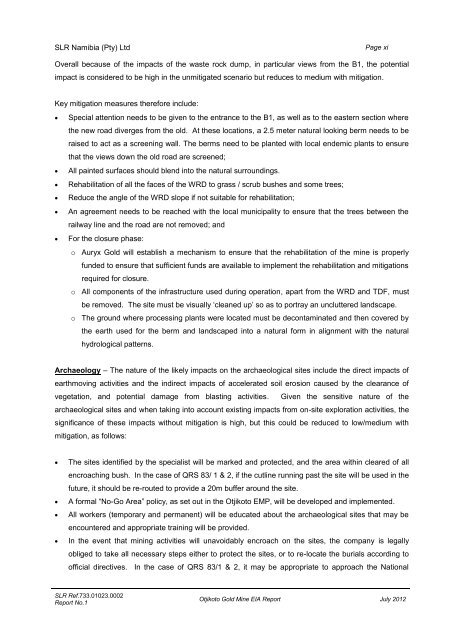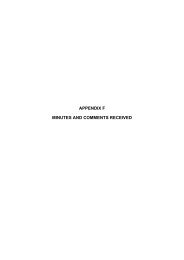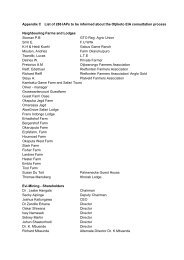2 Otjikoto Final EIA Report 5MB - Asecnam.com
2 Otjikoto Final EIA Report 5MB - Asecnam.com
2 Otjikoto Final EIA Report 5MB - Asecnam.com
You also want an ePaper? Increase the reach of your titles
YUMPU automatically turns print PDFs into web optimized ePapers that Google loves.
SLR Namibia (Pty) Ltd<br />
SLR Ref.733.01023.0002<br />
<strong>Report</strong> No.1<br />
Page xi<br />
Overall because of the impacts of the waste rock dump, in particular views from the B1, the potential<br />
impact is considered to be high in the unmitigated scenario but reduces to medium with mitigation.<br />
Key mitigation measures therefore include:<br />
� Special attention needs to be given to the entrance to the B1, as well as to the eastern section where<br />
the new road diverges from the old. At these locations, a 2.5 meter natural looking berm needs to be<br />
raised to act as a screening wall. The berms need to be planted with local endemic plants to ensure<br />
that the views down the old road are screened;<br />
� All painted surfaces should blend into the natural surroundings.<br />
� Rehabilitation of all the faces of the WRD to grass / scrub bushes and some trees;<br />
� Reduce the angle of the WRD slope if not suitable for rehabilitation;<br />
� An agreement needs to be reached with the local municipality to ensure that the trees between the<br />
railway line and the road are not removed; and<br />
� For the closure phase:<br />
o Auryx Gold will establish a mechanism to ensure that the rehabilitation of the mine is properly<br />
funded to ensure that sufficient funds are available to implement the rehabilitation and mitigations<br />
required for closure.<br />
o All <strong>com</strong>ponents of the infrastructure used during operation, apart from the WRD and TDF, must<br />
be removed. The site must be visually ‘cleaned up’ so as to portray an uncluttered landscape.<br />
o The ground where processing plants were located must be decontaminated and then covered by<br />
the earth used for the berm and landscaped into a natural form in alignment with the natural<br />
hydrological patterns.<br />
Archaeology – The nature of the likely impacts on the archaeological sites include the direct impacts of<br />
earthmoving activities and the indirect impacts of accelerated soil erosion caused by the clearance of<br />
vegetation, and potential damage from blasting activities. Given the sensitive nature of the<br />
archaeological sites and when taking into account existing impacts from on-site exploration activities, the<br />
significance of these impacts without mitigation is high, but this could be reduced to low/medium with<br />
mitigation, as follows:<br />
� The sites identified by the specialist will be marked and protected, and the area within cleared of all<br />
encroaching bush. In the case of QRS 83/ 1 & 2, if the cutline running past the site will be used in the<br />
future, it should be re-routed to provide a 20m buffer around the site.<br />
� A formal “No-Go Area” policy, as set out in the <strong>Otjikoto</strong> EMP, will be developed and implemented.<br />
� All workers (temporary and permanent) will be educated about the archaeological sites that may be<br />
encountered and appropriate training will be provided.<br />
� In the event that mining activities will unavoidably encroach on the sites, the <strong>com</strong>pany is legally<br />
obliged to take all necessary steps either to protect the sites, or to re-locate the burials according to<br />
official directives. In the case of QRS 83/1 & 2, it may be appropriate to approach the National<br />
<strong>Otjikoto</strong> Gold Mine <strong>EIA</strong> <strong>Report</strong> July 2012





